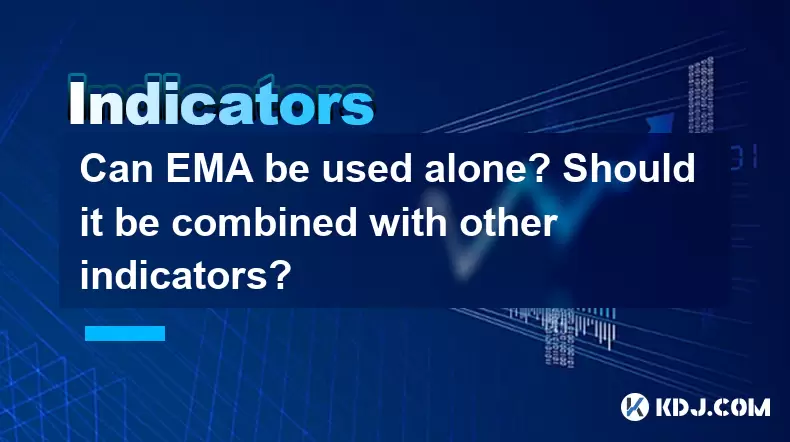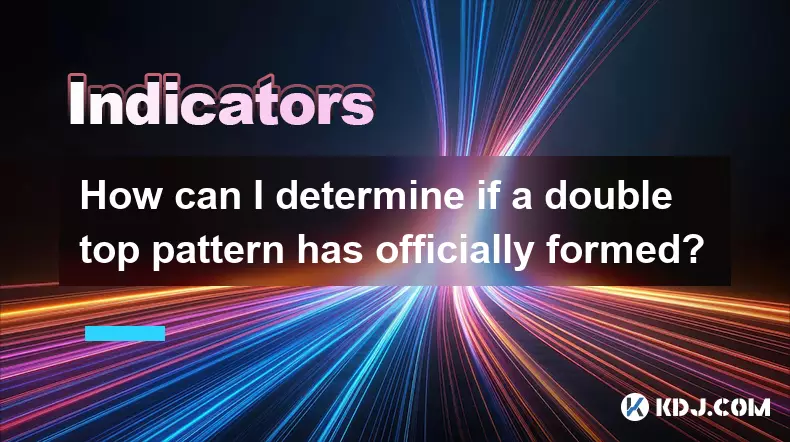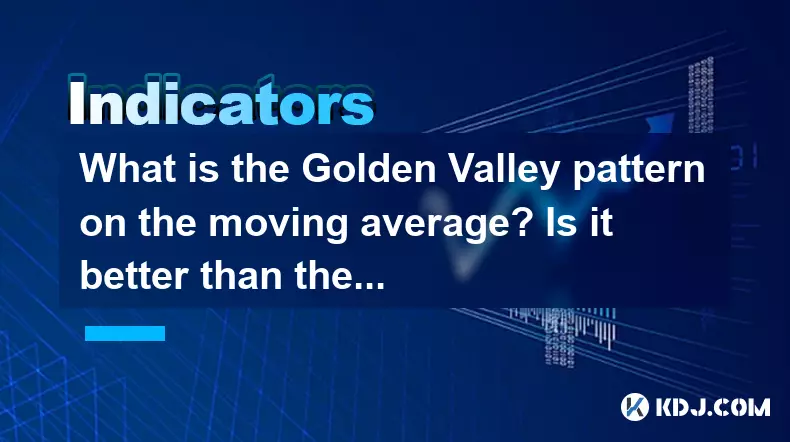-
 bitcoin
bitcoin $123963.239194 USD
1.37% -
 ethereum
ethereum $4529.082464 USD
1.07% -
 xrp
xrp $2.983640 USD
0.71% -
 tether
tether $1.000287 USD
0.02% -
 bnb
bnb $1179.874393 USD
2.99% -
 solana
solana $230.633678 USD
1.55% -
 usd-coin
usd-coin $0.999835 USD
0.03% -
 dogecoin
dogecoin $0.254240 USD
1.34% -
 tron
tron $0.341176 USD
0.15% -
 cardano
cardano $0.842285 USD
0.52% -
 hyperliquid
hyperliquid $48.537896 USD
-0.86% -
 chainlink
chainlink $21.863092 USD
-0.84% -
 ethena-usde
ethena-usde $0.999743 USD
-0.07% -
 sui
sui $3.579561 USD
-0.18% -
 stellar
stellar $0.403418 USD
2.67%
Can EMA be used alone? Should it be combined with other indicators?
EMA can be used alone for simple trend analysis but is more effective when combined with indicators like MACD, RSI, and volume to reduce false signals.
May 21, 2025 at 07:49 pm

Can EMA be Used Alone? Should it be Combined with Other Indicators?
The Exponential Moving Average (EMA) is a popular technical indicator used by traders within the cryptocurrency market to analyze price trends. The question of whether the EMA can be used alone or should be combined with other indicators is a common one among traders. This article will delve into the effectiveness of using the EMA as a standalone tool and explore the benefits of combining it with other indicators.
Understanding the EMA
The EMA is a type of moving average that places a greater weight and significance on the most recent data points. This makes it more responsive to new information compared to the Simple Moving Average (SMA). The formula for calculating the EMA is as follows:
[ \text{EMA} = (\text{Price} - \text{Previous EMA}) \times \text{Multiplier} + \text{Previous EMA} ]
Where the multiplier is calculated as:
[ \text{Multiplier} = \frac{2}{\text{Periods} + 1} ]
Traders often use different periods for the EMA, such as the 12-day and 26-day EMAs, to identify short-term and long-term trends.
Using the EMA Alone
Using the EMA alone can be effective for traders who prefer a straightforward approach to their analysis. The primary advantage of using the EMA as a standalone tool is its simplicity. Traders can quickly identify trends by observing the direction of the EMA line. For instance, if the EMA is sloping upwards, it indicates a bullish trend, while a downward slope suggests a bearish trend.
However, relying solely on the EMA can lead to false signals, especially in choppy or sideways markets. The EMA's responsiveness to recent price movements can sometimes result in whipsaws, where the indicator gives a buy or sell signal that quickly reverses. This can be particularly challenging for traders who do not employ additional confirmation methods.
Combining the EMA with Other Indicators
Combining the EMA with other indicators can enhance the accuracy of trading signals and provide a more comprehensive analysis of market conditions. One common approach is to use the EMA in conjunction with other types of moving averages, such as the SMA. By comparing the EMA and SMA, traders can identify crossovers that may signal potential entry or exit points.
- EMA and SMA Crossovers: When the EMA crosses above the SMA, it may indicate a potential bullish trend, and when it crosses below, it might suggest a bearish trend. This method can help traders confirm the direction of the market and reduce the likelihood of false signals.
Another popular combination is the use of the EMA with the Moving Average Convergence Divergence (MACD) indicator. The MACD is derived from the difference between two EMAs and can provide additional insights into momentum and trend strength.
- EMA and MACD: By observing the MACD line and signal line, traders can identify potential trend reversals. When the MACD line crosses above the signal line, it may indicate a bullish trend, and when it crosses below, it might suggest a bearish trend. Combining this with the EMA can provide a more robust trading strategy.
EMA and Volume Indicators
Volume indicators can also be effectively combined with the EMA to validate trends. One such indicator is the On-Balance Volume (OBV), which adds volume on up days and subtracts volume on down days. When the OBV rises alongside an upward-sloping EMA, it can confirm a bullish trend. Conversely, a falling OBV with a downward-sloping EMA may confirm a bearish trend.
- EMA and OBV: To use the EMA and OBV together, follow these steps:
- Plot the EMA on your chart.
- Plot the OBV below the price chart.
- Observe the direction of both the EMA and OBV. If both are trending in the same direction, it can confirm the trend.
EMA and Oscillators
Oscillators like the Relative Strength Index (RSI) and the Stochastic Oscillator can be used with the EMA to identify overbought or oversold conditions. When the EMA indicates a trend, and the oscillator suggests an overbought or oversold condition, it can provide a signal for potential reversals.
EMA and RSI: The RSI measures the speed and change of price movements. When the RSI is above 70, it indicates an overbought condition, and when it is below 30, it suggests an oversold condition. If the EMA is trending upwards and the RSI is above 70, it might signal a potential bearish reversal. Conversely, if the EMA is trending downwards and the RSI is below 30, it could indicate a potential bullish reversal.
EMA and Stochastic Oscillator: The Stochastic Oscillator compares a closing price to its price range over a certain period. When the Stochastic is above 80, it indicates an overbought condition, and when it is below 20, it suggests an oversold condition. Similar to the RSI, combining the Stochastic with the EMA can help traders identify potential trend reversals.
Practical Example of Combining EMA with Other Indicators
To illustrate the practical application of combining the EMA with other indicators, consider the following scenario:
- Scenario: A trader is analyzing the price chart of Bitcoin (BTC/USD) on a daily timeframe.
- EMA Settings: The trader uses a 50-day EMA to identify the overall trend.
- Additional Indicators: The trader also uses the MACD and RSI to confirm the trend and identify potential reversals.
Here are the steps the trader would follow:
- Plot the 50-day EMA: Observe the direction of the EMA to determine the trend.
- Plot the MACD: Look for crossovers between the MACD line and the signal line to confirm the trend direction.
- Plot the RSI: Monitor the RSI to identify potential overbought or oversold conditions.
- Analysis: If the 50-day EMA is sloping upwards, the MACD line crosses above the signal line, and the RSI is not in overbought territory, the trader might consider a long position. Conversely, if the EMA is sloping downwards, the MACD line crosses below the signal line, and the RSI is not in oversold territory, the trader might consider a short position.
Frequently Asked Questions
What are the most common periods used for the EMA in cryptocurrency trading?The most common periods used for the EMA in cryptocurrency trading are the 12-day, 26-day, and 50-day EMAs. The 12-day and 26-day EMAs are often used in conjunction with the MACD indicator, while the 50-day EMA is used to identify the overall trend.
Can the EMA be used effectively in highly volatile markets?The EMA can be used in highly volatile markets, but it is more prone to false signals due to its responsiveness to recent price movements. Combining the EMA with other indicators, such as volume indicators or oscillators, can help mitigate the impact of volatility and improve the accuracy of trading signals.
Is it necessary to use multiple EMAs, or is one sufficient?Using multiple EMAs can provide a more comprehensive view of the market by identifying both short-term and long-term trends. For example, a trader might use a 12-day EMA to identify short-term trends and a 50-day EMA to identify longer-term trends. However, using a single EMA can still be effective if combined with other indicators to confirm signals.
How often should the EMA be recalculated?The EMA should be recalculated with each new price data point. Most trading platforms and charting software automatically update the EMA in real-time, ensuring that traders have the most current information for their analysis.
Disclaimer:info@kdj.com
The information provided is not trading advice. kdj.com does not assume any responsibility for any investments made based on the information provided in this article. Cryptocurrencies are highly volatile and it is highly recommended that you invest with caution after thorough research!
If you believe that the content used on this website infringes your copyright, please contact us immediately (info@kdj.com) and we will delete it promptly.
- BlockDAG, DOGE, HYPE Sponsorship: Crypto Trends Shaping 2025
- 2025-10-01 00:25:13
- Deutsche Börse and Circle: A StableCoin Adoption Powerhouse in Europe
- 2025-10-01 00:25:13
- BlockDAG's Presale Buzz: Is It the Crypto to Watch in October 2025?
- 2025-10-01 00:30:13
- Bitcoin, Crypto, and IQ: When Genius Meets Digital Gold?
- 2025-10-01 00:30:13
- Stablecoins, American Innovation, and Wallet Tokens: The Next Frontier
- 2025-10-01 00:35:12
- NBU, Coins, and Crypto in Ukraine: A New Yorker's Take
- 2025-10-01 00:45:14
Related knowledge

What is a tower bottom candlestick pattern? Does it have a high success rate?
Sep 22,2025 at 07:18am
Tower Bottom Candlestick Pattern Explained1. The tower bottom candlestick pattern is a reversal formation that typically appears at the end of a downt...

What is a black hole pattern in the MACD indicator? Is it a cause for concern?
Sep 21,2025 at 06:54pm
Bitcoin's Role in Decentralized Finance1. Bitcoin remains the cornerstone of decentralized finance, serving as a benchmark for value and security acro...

How can I use the psychological line (PSY) to determine market sentiment?
Sep 17,2025 at 02:19pm
Understanding the Psychological Line (PSY) in Cryptocurrency TradingThe Psychological Line, commonly referred to as PSY, is a momentum oscillator used...

How can I determine if a double top pattern has officially formed?
Sep 21,2025 at 03:18am
Understanding the Structure of a Double Top Pattern1. A double top pattern consists of two distinct peaks that reach approximately the same price leve...

What is the Golden Valley pattern on the moving average? Is it better than the Silver Valley pattern?
Sep 21,2025 at 02:54pm
Understanding the Golden Valley Pattern in Moving Averages1. The Golden Valley pattern is a technical formation observed in cryptocurrency price chart...

What does a death cross of the RSI in the strong zone (above 50) mean?
Sep 17,2025 at 10:54pm
Understanding the Death Cross in RSI Context1. The term 'death cross' is traditionally associated with moving averages, where a short-term average cro...

What is a tower bottom candlestick pattern? Does it have a high success rate?
Sep 22,2025 at 07:18am
Tower Bottom Candlestick Pattern Explained1. The tower bottom candlestick pattern is a reversal formation that typically appears at the end of a downt...

What is a black hole pattern in the MACD indicator? Is it a cause for concern?
Sep 21,2025 at 06:54pm
Bitcoin's Role in Decentralized Finance1. Bitcoin remains the cornerstone of decentralized finance, serving as a benchmark for value and security acro...

How can I use the psychological line (PSY) to determine market sentiment?
Sep 17,2025 at 02:19pm
Understanding the Psychological Line (PSY) in Cryptocurrency TradingThe Psychological Line, commonly referred to as PSY, is a momentum oscillator used...

How can I determine if a double top pattern has officially formed?
Sep 21,2025 at 03:18am
Understanding the Structure of a Double Top Pattern1. A double top pattern consists of two distinct peaks that reach approximately the same price leve...

What is the Golden Valley pattern on the moving average? Is it better than the Silver Valley pattern?
Sep 21,2025 at 02:54pm
Understanding the Golden Valley Pattern in Moving Averages1. The Golden Valley pattern is a technical formation observed in cryptocurrency price chart...

What does a death cross of the RSI in the strong zone (above 50) mean?
Sep 17,2025 at 10:54pm
Understanding the Death Cross in RSI Context1. The term 'death cross' is traditionally associated with moving averages, where a short-term average cro...
See all articles










































































